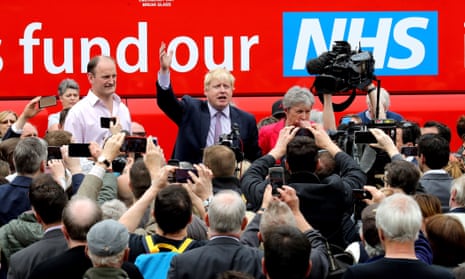For four days straight, Labour has led the political news. On Sunday it was Jeremy Corbyn with a set-piece interview on the Andrew Marr show, an exchange whose focus on nuclear weapons was still leading bulletins on Monday. On Tuesday, it was the turn of Keir Starmer as he set out Labour’s position on Brexit. Today it’s been the shadow health secretary, Jonathan Ashworth, promising a pay rise for NHS staff.
In a normal election campaign, such dominance of the news cycle would represent a major triumph. The two sides usually scrap for attention, and for one side to have gained so much more airtime than the other would look like a serious win. But there’s a difference this time. The Tories are not fighting Labour for the spotlight.
On the contrary, they have, quite deliberately, chosen to vacate the stage: they are organising few events and making next to no policy statements of their own. Instead they want the voters to take a long, hard look at Labour. They’ve decided the best advert for a strengthened Tory government is extended exposure to the prospect of a Labour one.
That’s because the premise of this campaign – indeed the premise of this entire election, called three years ahead of schedule – is the Tory calculation that voters see today’s Labour party as wholly unfit for office. The Conservatives are happy to let Labour have the floor, even to set out policies that polls show are fairly popular. They know that once those ideas are associated with Labour, they will be rejected – because voters made up their minds about the party, and especially its leader, long ago.
It’s this basic strategic judgment that explains many of the tactical decisions Theresa May and her team are making. Take the prime minister’s ducking of TV debates. She knows that that risks branding her as either cowardly – hence the reappearance of that old campaign standby, the man in a chicken suit – or fundamentally undemocratic, a leader who refuses to be held to account.
And yet May has clearly decided to risk that judgment rather than agree to a debate from which she stands only to lose, either through a misstep on the night or by granting Corbyn the appearance of parity, allowing him to stand alongside her as a would-be prime minister. She is so far in front she has no reason to do it.
But the enormous poll lead, and the presumption of victory that goes with it, has tactical complications too. May is deploying some of the same personnel and themes that brought the Tories success in 2015. Hence the return of Lynton Crosby and Barack Obama’s former number-cruncher, Jim Messina, and with them Crosby’s winning theme: the warning that a vote for Labour is a vote for a “coalition of chaos” that would hand a dominant role to the Scottish National party.
The trouble is, that tactic doesn’t quite fit the larger strategic picture. Such a warning worked well in 2015, when polls showed the two main parties neck and neck. This time, when the data shows the Tories ahead even in Wales, such talk sounds phoney.
The curious result is that while the Tory campaign might look a bit like 2015 on the outside, the underlying picture is very different. This phenomenon exists in human form in the unlikely shape of Boris Johnson. Once again, a Tory campaign finds itself exercised over what to do about him. Today’s Times reports that cabinet ministers are urging May to “sideline” the former mayor and allow him no more than a “cameo role”. He’s due to make a foreign policy speech today, and do some radio and TV later in the week, but otherwise he’s been conspicuously absent.
In 2015, there was similar stress over Johnson. But here’s the difference. Back then, the concern was that the London mayor might outshine David Cameron and George Osborne, that he would use the election campaign as an audition for the top job. In the end, Johnson was confined to drumming up support in marginal seats.
This time the worry is that he could be a drag on May, reminding voters of the fraudulent pledges of the leave campaign, including the notoriously bogus £350m a week for the NHS. The Times quotes one party source asking: “What are we going to put on the side of his bus?”
Johnson was a problem in 2015, and is a problem in 2017 too. But the difference is telling. Back then, he was deemed an asset. Now his own colleagues view him as a liability. What happened in between was, of course, the event that changed everything, reshaping the landscape on which this entire election is being fought: in a word, Brexit.






